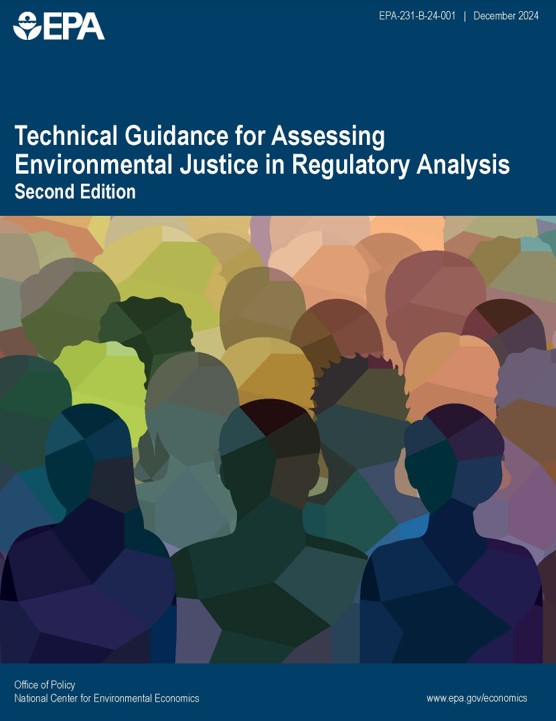Technical Guidance for Assessing Environmental Justice in Regulatory Analysis

- What is the Technical Guidance for Assessing Environmental Justice in Regulatory Analysis (EJ Technical Guidance or EJTG)?
- Why is the EJ Technical Guidance important?
- What topics are covered in the EJ Technical Guidance?
- Who will use the EJ Technical Guidance?
- How was the EJ Technical Guidance Developed?
What is the Technical Guidance for Assessing Environmental Justice in Regulatory Analysis (EJ Technical Guidance or EJTG)?
The Technical Guidance for Assessing Environmental Justice in Regulatory Analysis (EJ Technical Guidance) is designed to help EPA analysts evaluate potential environmental justice (EJ) concerns associated with EPA regulatory actions. It provides recommendations for analysts on how to assess the existence of EJ concerns prior to the rulemaking and whether such concerns are exacerbated, mitigated, or remain unchanged for each regulatory option under consideration.
Why is the EJ Technical Guidance important?
The EJ Technical Guidance makes five main recommendations designed to ensure consistency across EPA assessments of potential EJ concerns for regulatory actions. The recommendations encourage analysts to conduct the highest quality analysis feasible, recognizing that data limitations, time and resource constraints, and analytic challenges will vary by media and circumstance. They are not designed to be prescriptive and do not mandate the use of a specific approach. Analysts should use their best professional judgement to decide on the type of analysis that is feasible and appropriate within a specific regulatory context. The recommendations are:
- When risks, exposures, outcomes, or benefits are quantified, some level of quantitative EJ analysis is recommended.
- Analysts should integrate EJ into the planning of a risk assessment conducted for the regulatory action.
- Analysts should strive to characterize the distribution of risks, exposures, or outcomes within each population group, not just average effects.
- Analysts should follow best practices appropriate to the analytic questions at hand.
- As relevant, analysts should consider any economic challenges that may be exacerbated by the regulatory action for relevant population groups of concern.
What topics are covered in the EJ Technical Guidance?
The EJ Technical Guidance is organized into seven chapters and two appendices. A separate compendium of examples from recent EJ analyses conducted for EPA rulemakings is also available here. (PDF, 28 pp, 1.5 MB).
- Chapter 1 provides background and outlines the main objectives of the guidance.
- Chapter 2 reviews key EJ concepts that are expected to influence analytic considerations.
- Chapter 3 discusses three questions analysts should strive to answer when evaluating EJ concerns, outlines the key steps of an EJ analysis, and presents overarching recommendations and best practices to guide assessments of EJ concerns for EPA regulatory actions.
- Chapter 4 identifies factors that can result in differential patterns of exposure to environmental hazards for some population groups, and/or a greater response of some individuals to a given level of exposure.
- Chapter 5 provides guidance on incorporating EJ concerns into the planning of an HHRA, including descriptions of available methodologies and tools .
- Chapter 6 discusses how to identify and evaluate the feasibility and appropriateness of different analytic approaches and tools for assessing EJ concerns; the types of information that should be included in the assessment; other analytic considerations that could affect results; and how to consider costs and non-health effects in the assessment.
- Chapter 7 provides information on research goals to improve assessment of EJ at the EPA.
- Appendix A provides links to additional EPA guidance that may be helpful when assessing EJ concerns.
- Appendix B provides examples of approaches for incorporating EJ concerns into the planning of exposure and dose-response assessments.
Who will use the EJ Technical Guidance?
The primary users of the EJ Technical Guidance are EPA analysts, such as economists and risk assessors, who are developing or overseeing the development of analyses to support regulations.
How was the EJ Technical Guidance Developed?
The EJ Technical Guidance has been updated to reflect the latest state of the science, new peer-reviewed Agency guidance; and lessons learned from conducting environmental justice analysis for EPA rulemakings since publication of the original guidance. It underwent external peer-review by a special panel of EPA's Science Advisory Board. Information on the external peer review is available through the SAB website. In addition, the draft revision of this document was published in the Federal Register for a 60-day public comment period, which was then extended for an additional 14 days. The EPA also conducted a Tribal consultation process concurrent with the public comment period.
The prior version of the EJ Technical Guidance can be found here. (PDF, 120 pp, 3.0 MB).
